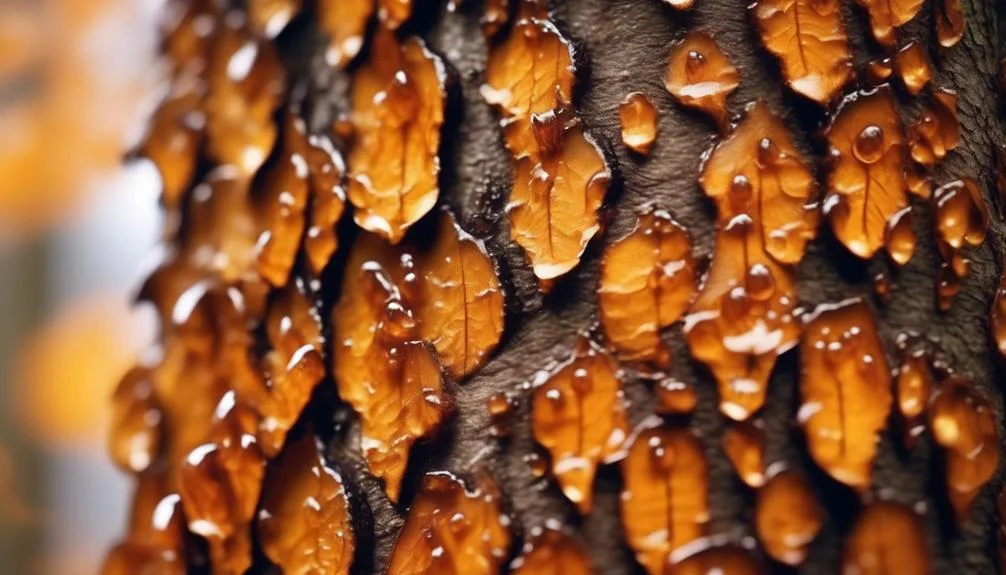Curious about beech tree sap? We often associate sap with maple trees, but beech tree sap has its own potential.
It could have medicinal, practical, and industrial uses. The possibilities of this natural substance are worth exploring.
Before you dismiss it, consider the potential benefits of beech tree sap.
Medicinal Properties of Beech Tree Sap
Discover the numerous medicinal properties of beech tree sap, ranging from its traditional use in folk medicine to its potential modern applications in healthcare.
For centuries, beech tree sap has been recognized for its healing benefits and has been used in various natural remedies. The sap is rich in antioxidants, which can help fight inflammation and boost the immune system. Its antiseptic properties make it effective in treating minor cuts and wounds.
Additionally, beech tree sap has been found to have potential in supporting respiratory health and soothing skin irritations. Modern research is also exploring its use in pharmaceuticals and skincare products.
With its long history of traditional use and promising modern applications, beech tree sap continues to be a fascinating subject in the world of natural medicine.
Practical Uses for Beech Tree Sap
With its diverse array of practical applications, beech tree sap is a valuable natural resource that can be utilized in various everyday scenarios. Here are some practical uses for beech tree sap:
- Beauty Products: Beech tree sap is a natural ingredient that can be used in the production of skincare and beauty products. Its moisturizing and nourishing properties make it an excellent addition to lotions, balms, and creams.
- Woodworking Finishes: The sap of beech trees can be processed into a natural wood finish, providing a protective and lustrous coating for woodworking projects. It enhances the natural beauty of wood while offering durable protection from the elements.
- Adhesive: Beech tree sap can be used as a natural adhesive in woodworking and craft projects, serving as a sustainable alternative to synthetic adhesives.
- Flavoring Agent: In some cultures, beech tree sap is used as a flavoring agent in cooking and baking, adding a unique and subtle sweetness to dishes.
Nutritional Value of Beech Tree Sap
Exploring the nutritional benefits of beech tree sap reveals its potential as a valuable source of essential nutrients for various applications.
Beech tree sap is rich in essential minerals such as potassium, calcium, manganese, and zinc, as well as antioxidants and organic acids.
This natural elixir also contains a range of vitamins including vitamin C, which supports immune function, and B vitamins that aid in energy production.
The nutrient content of beech tree sap contributes to its potential health benefits, such as supporting hydration, promoting healthy skin, and boosting overall vitality.
Additionally, the presence of antioxidants in the sap may help combat oxidative stress in the body.
With its impressive nutrient profile, beech tree sap shows promise as a beneficial addition to a balanced diet and holistic wellness regimen.
Industrial Applications of Beech Tree Sap
Beech tree sap has found diverse industrial applications, ranging from the production of natural adhesives and sealants to its use in traditional folk medicine and skincare products. Here are some remarkable industrial uses of beech tree sap:
- Wood Preservation and Adhesive: The sap contains natural compounds that make it suitable for wood preservation and as an adhesive in woodworking and furniture making.
- Textile Dye and Tanning Agent: Beech tree sap is used as a natural dye for textiles, creating unique and earthy colors. It also serves as a tanning agent in leather production, contributing to the creation of high-quality leather goods.
- Traditional Folk Medicine: Beech tree sap is harnessed for its medicinal properties, particularly in traditional folk medicine for various health and wellness applications.
- Skincare Products: The sap is utilized in skincare products for its moisturizing and soothing properties, offering natural benefits for skin health.
Traditional and Cultural Uses of Beech Tree Sap
Having explored the various industrial applications of beech tree sap, it's fascinating to uncover its traditional and cultural uses, shedding light on its historical significance and enduring relevance in different societies.
In various cultures, beech tree sap has been used in folk remedies for its perceived health benefits. It has been employed as a natural remedy for coughs, sore throats, and skin irritations.
Additionally, the artistic uses of beech tree sap are equally intriguing. Some traditional craftsmen use it as a natural adhesive in woodworking and joinery, while others have incorporated it into traditional paint and dye-making processes.
The rich cultural and traditional significance of beech tree sap showcases its versatility and the deep-rooted connection between nature and human innovation.
Conclusion
In light of the many practical and medicinal uses of beech tree sap, it's clear that this natural resource holds significant value.
Whether in traditional remedies or industrial applications, its versatility has stood the test of time.
The next time you encounter beech tree sap, consider the myriad ways it can contribute to our well-being and industry.

My interest in trees started when I first saw the giant sequoias in Yosemite.
I was a teenager then, and I remember thinking, “I need to learn more about this.”
That moment stuck with me.
A few years later, I went on to study forestry at Michigan Tech.
Since graduating, I’ve worked in a mix of hands-on tree care and community education.
I’ve spent over ten years helping people understand how to plant, maintain, and protect the trees in their neighborhoods.
I don’t see trees as just part of the landscape.
They are living things that make a real difference in our daily lives.
